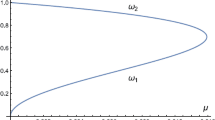Abstract
The collinear equilibrium points L1, L2 of the restricted three-body problem (spatial,circular) are unstable. For each of them there is a family of planar hyperbolic periodic orbits (Lyapunov family) around the equilibrium point. When the vertical stability parameter (in the sense of Henon) of these periodic orbits is equal to 1 the planar family bifurcates to a (symmetrical) couple of spatial families of (symmetrical) periodic orbits which are called halo orbits.
Richardson obtained these periodic orbits as power series in the amplitudes in x, Ax and z, Az, up to third order. Ax and Az are taken as the coefficients of the first cosine terms in the Fourier development of x and z. Using the Lindstedt-Poincaré method the Fourier series for the halo families are obtained to any order in a recurrent analytical way. These series are convergent if, for all points of the orbit, the distance to the related equilibrium point is less than the distance to the primaries.
The same ideas together with Floquet’s theory are applied to solve the variational equations along the halo orbits. In this way we get the stable, Ws, and unstable, Wu, manifolds associated to the periodic orbit. We note that, for not too large amplitudes, both invariant manifolds are 2-dimensional. For the Earth-Sun case, Az = 210000 km the errors of an 11 order theory with respect to the numerical results are less than 1 km in position and 1 mm/s in velocity.
Numerical continuation has been used for the halo families in the Hill’s problem and in restricted three-body problem small μ. For the Hill’s case both families are symmetrical and they end in a vertical collision orbit. By a careful analysis of the restricted three-body problem seen as a perturbation 0(μ1/3) of the Hill’s one it has been shown that both families go near almost vertical periodic orbits. One of them (related to the outer point) decreases in size and ends shrinking to the small body and the other increases in size ending in a retrograde periodic orbit around both primaries.
Natural extensions to account for perturbations (eccentricity, external bodies, radiation pressure, etc.) allow to obtain analytical quasiperiodic solutions for the orbit and the solutions for the related variational equations.
Access this chapter
Tax calculation will be finalised at checkout
Purchases are for personal use only
Similar content being viewed by others
Author information
Authors and Affiliations
Editor information
Editors and Affiliations
Rights and permissions
Copyright information
© 1985 D. Reidel Publishing Company
About this chapter
Cite this chapter
Simo, C., Martínez, R. (1985). Analytical Expressions for Some Spatial Periodic Orbits of the Restricted Three-Body Problem and Their Invariant Manifolds. In: Szebehely, V.G. (eds) Stability of the Solar System and Its Minor Natural and Artificial Bodies. NATO ASI Series, vol 154. Springer, Dordrecht. https://doi.org/10.1007/978-94-009-5398-7_59
Download citation
DOI: https://doi.org/10.1007/978-94-009-5398-7_59
Publisher Name: Springer, Dordrecht
Print ISBN: 978-94-010-8883-1
Online ISBN: 978-94-009-5398-7
eBook Packages: Springer Book Archive




